Showing 2077–2088 of 2164 resultsSorted by popularity
-

Dasylirion Wheeleri 20lt
R435.00Add to cartDasylirion Wheeleri 20lt
Common Name: Desert SpoonApprox 0.5m Tall
-
Sale!
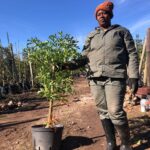
Cussonia Spicata 20lt
Original price was: R550.00.R349.99Current price is: R349.99.Add to cartCussonia Spicata 20lt
Common Name: Cabbage TreeFull Sun
Evergreen
Indigenous
Wind TolerantCussonia spicata, commonly known as the cabbage tree, is a species of tree native to parts of southern and eastern Africa, including South Africa, Eswatini (Swaziland), Zimbabwe, Mozambique, and eastern tropical Africa.
🌳 General Description
Family: Araliaceae
Common Names: Cabbage tree, Spiked Cabbage Tree
Height: Typically grows 5–15 meters tall
Growth Form: Often has a single, thick trunk with a sparse, rounded crown🍃 Leaves
Type: Large, leathery, palmately compound (resembling fingers on a hand)
Arrangement: Clusters at the ends of thick branches
Colour: Blue-green to grey-green
Appearance: The leaf shape and arrangement give the tree a cabbage-like look🌸 Flowers and Fruit
Flowers: Small, greenish-yellow, borne in dense, spiky heads on tall, branched stalks
Blooming Season: Late summer to autumn
Fruit: Small, roundish drupe that turns purple when ripe🐘 Ecological Role
Wildlife: Leaves and bark are browsed by elephants and other herbivores
Birds and Insects: Attracted to flowers for nectar and fruit for food -
Sale!
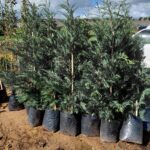
Cupressus Leylandii 20lt
Original price was: R650.00.R399.99Current price is: R399.99.Add to cartCupressus Leylandii 20lt
Common Name: Leyland Cypress Tree
-
Sale!
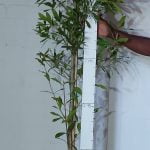
Combretum Krausii 20lt
Original price was: R495.00.R379.99Current price is: R379.99.Add to cartCombretum Krausii 20lt
Common Name: Forest BushwillowCombretum krausii, commonly known as Forest Bushwillow, is a species of flowering tree belonging to the Combretaceae family. It is native to various regions in southern Africa, including countries such as South Africa, Zimbabwe, and Mozambique. Forest Bushwillow is a characteristic tree of wooded and forested areas in its native range.
Appearance: Forest Bushwillow is a medium to large-sized tree that can grow up to 10-20 meters in height, although it may reach greater heights under favourable conditions. It has a straight, cylindrical trunk and a spreading, rounded crown with dense foliage.
Leaves: The leaves are simple, opposite or subopposite, and usually measure around 5-10 cm in length. They are elliptical to lance-shaped and have a glossy green appearance. The leaves turn yellow or orange in the fall before shedding.
Flowers: The tree produces small, inconspicuous flowers that are greenish or cream-colored. The flowers are borne in dense, elongated spikes, which are attractive to various pollinators like bees and butterflies.
Fruits: After flowering, Forest Bushwillow develops fruits that are small, woody capsules containing seeds. The fruits are often eaten and dispersed by birds and other wildlife.
Habitat: As its name suggests, Forest Bushwillow is typically found in wooded areas, forests, and along riverbanks in its native range. It prefers well-drained soils and can tolerate a range of environmental conditions.
Uses: Combretum krausii has some uses in traditional medicine in certain regions. The tree’s bark and leaves are sometimes used for medicinal purposes by local communities. Additionally, the wood of Forest Bushwillow is used for various purposes, including making furniture and as firewood.
-
Sale!
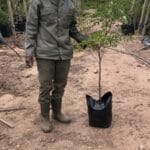
Caesalpinia Ferrea (Leopard Tree) 20lt
Original price was: R650.00.R439.99Current price is: R439.99.Add to cartCaesalpinia Ferrea 20lt
Common Name: Leopard TreeCaesalpinia ferrea, commonly known as Leopard Tree or Brazilwood, is a species of flowering tree belonging to the Fabaceae family. It is native to various regions in South America.
Appearance: The Leopard Tree is a medium-sized deciduous tree that can reach a height of 10 to 15 meters. It has an open, spreading crown with a rounded or umbrella-like shape. The tree’s bark is distinctive, with a mottled pattern of dark brown and light grey, resembling the coat of a leopard, which is the origin of its common name.
Leaves: The leaves are bipinnately compound, meaning they are divided into smaller leaflets, giving them a fern-like appearance. The leaflets are small and arranged along a central rachis (main axis). The leaves are usually green during the growing season but turn yellow or yellow-green before shedding in the fall.
Flowers: The tree produces small, bright yellow flowers with long stamens that are held in clusters. The flowers are attractive and serve as a nectar source for various pollinators, such as bees and butterflies.
Fruits: After flowering, Caesalpinia ferrea forms elongated pods that contain seeds. These pods are woody and brown in colour.
Habitat: The Leopard Tree is adaptable to various soil types and can thrive in both moist and drier conditions. It is commonly found in tropical and subtropical regions, especially in open woodlands and savannas.
Uses: The wood of Caesalpinia ferrea is durable and has been used for various purposes, including construction, furniture, and tools. In some regions, the tree is also valued for its ornamental qualities and is planted in parks, gardens, and along streets.
-
Sale!

Anastrabe Integerrima 10lt
Original price was: R220.00.R159.99Current price is: R159.99.Add to cartAnastrabe Integerrima 10lt
Common Name: Pambati TreeApprox 0.6m tall
-

Parsley Moss Curled 6 Pack Tray
R49.99Add to cartParsley Moss Curled 6 Pack Tray
We have a new range of 6 pack vegetable and herb plants on offer.
The stock of these changes daily so we will inform you should your item be suddenly out of stock.Happy Gardening!!
-
Sale!

Cabbage Green 6 Pack Tray
Original price was: R60.00.R49.99Current price is: R49.99.Add to cartCabbage Green 6 Pack Tray
Growing your own vegetables offers numerous benefits, both for your health and overall well-being. Here are some of the key advantages of cultivating your own vegetables:
1. Nutritional Value: Homegrown vegetables are incredibly fresh and packed with essential nutrients. They are harvested at their peak, ensuring optimal nutritional value. You have control over the cultivation methods, allowing you to avoid pesticides or other harmful chemicals.
2. Health and Wellness: Consuming homegrown vegetables promotes a healthier lifestyle. They are typically richer in vitamins, minerals, and antioxidants, which can boost your immune system, improve digestion, and lower the risk of chronic diseases such as heart disease and certain cancers.
3. Cost Savings: Growing your own vegetables can save you money in the long run. The initial investment in plants, soil, and tools may be modest, and the ongoing expenses are significantly lower compared to purchasing fresh produce from the market. Plus, you can grow a variety of vegetables at a fraction of the cost of buying them.
4. Taste and Flavour: Homegrown vegetables often have superior taste and flavour compared to store-bought produce. You can pick them at the peak of ripeness, allowing you to savour the true essence of each vegetable. The freshness and flavours of your homegrown vegetables can enhance your culinary experiences.
5. Environmental Sustainability: Cultivating your own vegetables promotes sustainable practices. By growing your food locally, you reduce the carbon footprint associated with long-distance transportation, packaging waste, and the use of harmful chemicals. Additionally, you can compost kitchen scraps and organic waste, minimizing landfill contributions.
6. Physical Activity and Stress Relief: Gardening is an excellent form of physical activity. It involves various tasks like digging, planting, weeding, and harvesting, which can provide exercise for your body. Engaging in gardening activities can also be therapeutic, reducing stress, anxiety, and promoting relaxation.
7. Educational and Skill Development: Growing your own vegetables offers a valuable learning experience for both children and adults. It allows you to understand the importance of sustainable agriculture, appreciate the effort involved in food production, and gain knowledge about plant biology and gardening techniques. It can also encourage a sense of responsibility and patience.
8. Food Security: Having your own vegetable garden contributes to food security. It provides you with a reliable source of fresh produce, reducing dependence on external suppliers. In times of emergencies or disruptions in the food supply chain, you can rely on the sustenance from your homegrown vegetables.
9. Aesthetics and Connection with Nature: Growing vegetables adds beauty to your surroundings. A well-maintained garden can enhance the aesthetics of your home and create a peaceful environment. It allows you to reconnect with nature, appreciate the seasons, and gain a sense of accomplishment.
Overall, growing your own vegetables offers a multitude of benefits, including improved nutrition, cost savings, environmental sustainability, physical activity, and a deeper connection with nature. It’s a rewarding endeavour that can positively impact your health, well-being, and overall quality of life.
-
Sale!

Gardenia Floribunda 10lt
Original price was: R295.00.R210.00Current price is: R210.00.Add to cartGardenia Floribunda 10lt
Full Sun
Semi Shade
Medium Watering
EvergreenGardenia floribunda, commonly known as Forest Gardenia or Wild Gardenia, is a species of flowering plant in the Rubiaceae family. It is native to various regions in Southeast Asia and the Pacific Islands. Gardenia floribunda is a small to medium-sized tree or shrub, highly valued for its fragrant and beautiful white flowers.
Appearance: Gardenia floribunda is a slow-growing evergreen shrub or small tree that can reach heights of 2 to 6m. It has a dense, compact growth habit with shiny, dark green leaves that are lanceolate or elliptical in shape.
Flowers: One of the main attractions of Gardenia floribunda is its fragrant white flowers. The flowers are usually large, trumpet-shaped, and have a waxy texture. They typically have five or six petals and emit a sweet, intense fragrance, especially in the evening. The flowers can appear throughout the year, but they are most abundant during the flowering season.
Fragrance: The strong, sweet fragrance of Gardenia floribunda flowers is highly prized and often used in perfumery and the creation of scented products.
Growth Requirements: Forest Gardenia thrives in warm, tropical or subtropical climates. It prefers well-draining, slightly acidic soil and typically grows best in full sun to partial shade. Regular watering and humidity are beneficial for its overall health and flowering performance.
Uses: Gardenia floribunda is commonly grown as an ornamental plant in gardens, parks, and landscapes. Its attractive foliage and beautifully scented flowers make it a popular choice for those who seek a sensory-rich garden experience.
Wildlife Attraction: The fragrant flowers of Gardenia floribunda attract various pollinators, including bees and butterflies, which contribute to its ecological significance.
-
Sale!

Elegia Tectorum 20lt
Original price was: R650.00.R425.00Current price is: R425.00.Add to cartElegia Tectorum 20lt
Full Sun
Semi Shade
Water Wise
Evergreen -
Sale!

Heart Leaf Philodendron 20cm Hanging Basket
Original price was: R245.00.R159.99Current price is: R159.99.Add to cartPhilodendron Scanden 20cm Hanging Basket
Common Name: Heart Leaf PhilodendronPhilodendron scandens, also known as heartleaf philodendron or sweetheart plant, is a popular indoor plant prized for its trailing vines and heart-shaped leaves. It belongs to the Araceae family and is native to the tropical regions of Central America and the Caribbean.
Heart-shaped leaves
As the common name suggests, the leaves of Philodendron scandens are heart-shaped, glossy, and typically dark green. The foliage may vary slightly in size and color depending on the specific variety.Trailing vines
This plant is known for its trailing growth habit, making it ideal for hanging baskets or climbing up supports. It can grow quite long if given the space and support to do so.Easy care
Philodendron scandens is relatively easy to care for, making it a popular choice for indoor gardeners, including beginners. It thrives in moderate to bright, indirect light but can tolerate lower light conditions. Avoid direct sunlight, as it can scorch the leaves.Watering
Allow the top inch or so of the soil to dry out between waterings. Overwatering can lead to root rot, so it’s essential to let the soil dry slightly before watering again. Ensure proper drainage in the pot to prevent waterlogged soil.Temperature and humidity
Philodendron scandens prefers temperatures between 18°C to 27°C and appreciates moderate to high humidity. If the air in your home is dry, you can increase humidity by misting the leaves, placing the plant on a humidity tray, or using a humidifier.Fertilising
During the growing season (spring and summer), fertilise Philodendron scandens monthly with a balanced houseplant fertiliser diluted to half strength. Reduce or stop fertilising during the fall and winter months when growth slows down. -
Sale!
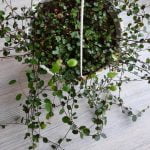
Muehlenbeckia Axillaris (Creeping Wire Vine) 20cm Hanging Basket
Original price was: R295.00.R189.99Current price is: R189.99.Add to cartMuehlenbeckia Axillaris also known as Creeping Wire Vine, 20cm Hanging Basket
